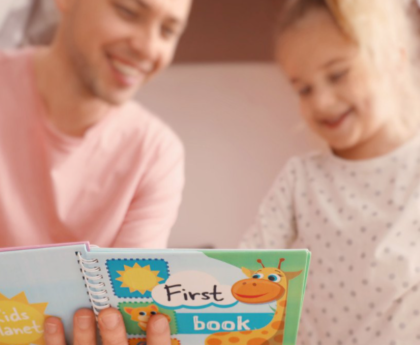When your child is learning how to read, it’s an exciting and rewarding time. As parents, we all want to see our children grow into literate, successful individuals—both academically and as human beings.
But for some children, learning to read isn’t the most empowering or life-changing experience. Some kids really struggle. In that case, what can we do to help struggling readers?
Let’s talk about it.
Is Your Child Struggling to Read?
Children can struggle with reading for all sorts of reasons—from cognitive to emotional to motivational and more.
In this article, we refer to struggling readers as children who face significant challenges in learning how to read despite receiving literacy instruction. Whether these struggles manifest as decoding difficulties, comprehension difficulties, or a mixture of both, it’s important to address these challenges early.
Signs of reading difficulties in children include:
- Trouble sounding out words (decoding)
- Slow and/or inaccurate reading
- Difficulty understanding what is being read or what has been read (comprehension)
- Skipping words mid-sentence or rushing through a piece of text
- Confusing the sounds of alphabetical letters in words
- Frequently guessing unfamiliar words instead of sounding them out
- Stopping to sound out familiar words every time they appear in print
- Poor spelling skills
For children who can decode and comprehend text but struggle with behavioral resistance toward reading, check out the article: Help! My Kid Hates to Read.
Strategies to Help Struggling Readers
Fortunately, there are a growing number of resources to help struggling readers today. Reading interventions and classroom accommodations are available in many regions of the world. People who struggle with learning to read need both interventions and accommodations in order to be successful in school.
Effective strategies are typically based on the science of reading, which uses evidence-based practices that support how children’s brains learn to read. These strategies include explicit, systematic instruction methods that strengthen foundational skills from the ground up.
Reading Interventions
Many struggling readers benefit from a reading intervention. This is a targeted, intensive form of instruction that a teacher or specialist provides.
Interventions focus on various methods, depending on the child’s specific needs.
Readers can be described in four general categories:
- Average/Advanced reader: good language comprehension and good decoding skills
- Compensator or Dyslexia: good language comprehension and poor decoding skills
- Hyperlexia: poor language comprehension, excellent decoding skills
- Mixed Type: poor language comprehension and poor decoding skills
It is important to match the type of intervention to the specific strengths and deficits a child may have in reading skills. The following approaches may be used to support literacy learning:
- Phonics Instruction: Because phonics is the foundation of reading, interventions often incorporate explicit phonics instruction to help children gain proficient decoding skills.
- Reading Comprehension: Children who struggle with comprehension receive active, engaging support to help them build these skills. Practices include vocabulary instruction, story prediction, summarizing, sequencing, practical application, and question-answer relationship (QAR).
- Multisensory Approach: Children with reading or learning difficulties may benefit from a multisensory approach to instruction. Interventionists use more sensory activities to integrate physical movements with visual and auditory stimuli, encouraging the brain to develop essential reading skills.
- One-on-one Instruction: Individualized instruction can help struggling readers gain the support and encouragement they need to make progress. A reading specialist or interventionist provides feedback and addresses the child’s specific needs, often giving parents helpful tasks to supplement reading education at home.
Reading interventions can be offered to an entire class, small group, or individual student, depending on the severity of risk among the student(s). Intensive interventions have been shown to improve reading outcomes, especially among early readers in kindergarten through third grade.
Reading Accommodations for Students
Accommodations help students who have been diagnosed with a learning disability (LD) achieve equal access to educational opportunities. Accommodations equip LD students to “level the playing field” with other children in their grade or age group.
The child’s parents typically decide a child’s accommodations in their IEP (Individualized Education Program) and then request their teachers or school accommodate them.
Accommodations are grouped into several categories:
- Presentation: Removes barriers in the way information is presented to the student, such as allowing a child to listen to an audiobook instead of reading an assigned text.
- Response: Adjusts the expected response required for an assignment, such as letting a child give verbal responses instead of writing them down.
- Timing/Scheduling: Changes the schedule or time allowed for a child to complete a task, such as extending a timed activity or allowing frequent breaks during class.
- Setting: Provides a change of environment during a task, such as allowing a child to take a test in a smaller group or separate room with minimal distractions.
- Other: Provides additional accommodations such as support with task management or extended test preparation.
The purpose of accommodations is not to create an unfair advantage. Instead, accommodations encourage a child to access academic success that would be otherwise limited by their learning disability.
Literacy Instruction Best Practices for Struggling Readers
Whether the whole class is struggling to read and needs an intervention or an individual student with a diagnosed learning difficulty requires accommodations, there are several best practices used for literacy instruction.
- Screen all students at the beginning of the year to identify signs of reading difficulties.
- Provide explicit, systematic instruction that’s cumulative and consistent.
- Re-assess students at the middle and end of the academic year to highlight areas of growth and observe data regarding additional learning needs.
- Guide readers through scaffolded reading practices to promote self-agency and confidence.
- Expose the child to more frequent reading activities—individually, with family, and in small groups.
- Offer consistent praise for reading achievements.
- Model accurate reading strategies, fluency, and self-correction.
- Allow digital reading tools that assist in decoding, comprehension, and other science-based reading skills.
- Monitor progress.
Helping struggling early readers requires patience and commitment to evidence-based instruction. Do your best to understand the root cause of your child’s difficulties, find adequate support, and empower your child to discover a love of reading.
Strengthen Your Child’s Reading Journey
To find reading help for struggling readers, start with a reliable assessment. Reading assessments provide insight into the child’s literacy strengths and weaknesses, pointing out the best next step to support them. Consider meeting with a psychologist or reading specialist if your child is showing signs of a learning disorder.
Whether your child is new to reading or in need of extra support, reading.com has some helpful resources for children and their families. Explore our reading tips and learning apps to help your child strengthen their reading abilities today!





